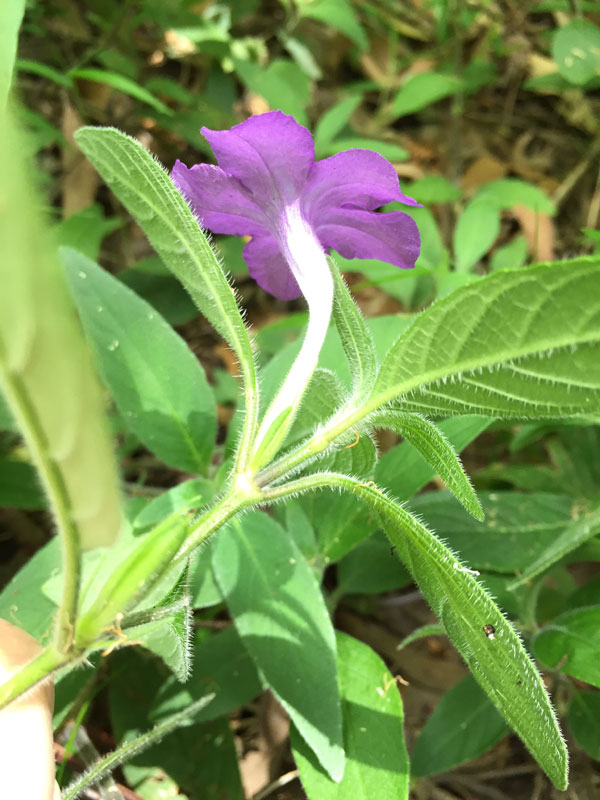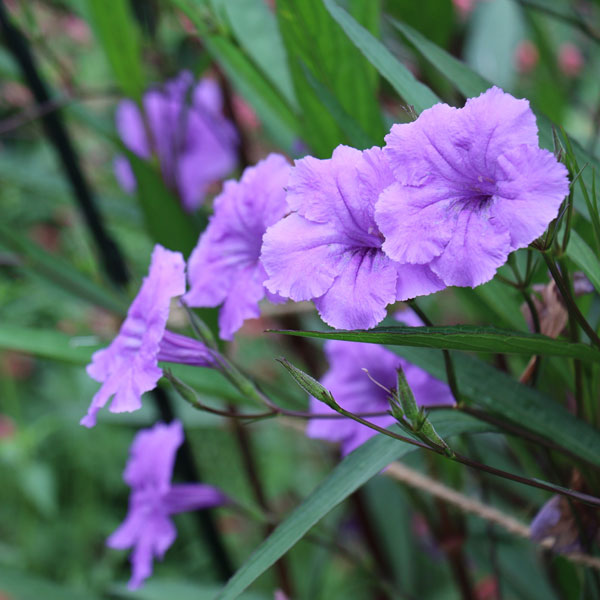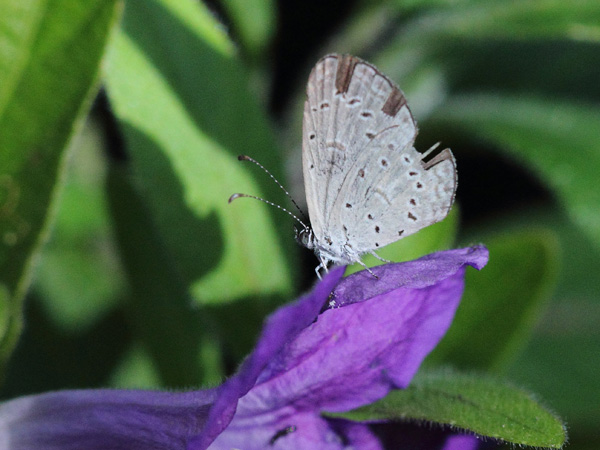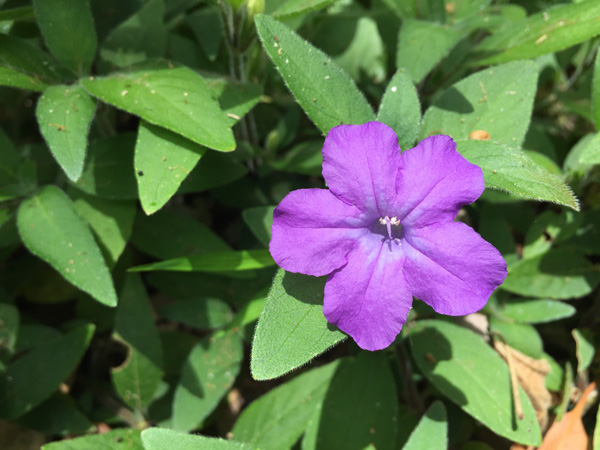There are two similar looking species of Ruellia that have escaped from being garden ornamentals to emerging environmental weeds across a broad range of habitats in South East Queensland (SEQ).
Creeping Ruellia (Ruellia squarrosa)
Also known as Water Bluebell or Blue Shade, this plant is native to southern Mexico and occurs in natural watercourses, forest edges and disturbed zones. It is a sprawling perennial herb with branches to 60cm. It has square stems which grow from underground rhizomes.
The leaves are 7cm long x 2-3cm wide and are soft, green and fuzzy with dense white hairs, particularly in younger leaves. The soft flowers are tubular, 4cm long and around 5cm across, with 5 petal lobes and are mauve to bluish-pink in colour. These develop into small, cigar shaped capsules, 12-15mm long, containing 16-20 seeds, which dry out and explode, scattering the seeds.
Creeping Ruellia flowers for most of the year and is more likely to spread by underground runners than by seed.


Mexican Petunia (Ruellia simplex, synonyms R. tweediana, R. brittonia)
Also known as Mexican Bluebell or Britton’s Wild Petunia, this plant is native to Mexico, the Caribbean and South America. It now occurs across SEQ in natural waterways, drains, dams, ponds, and wetlands.
This plant also grows from underground rhizomes and can become a multistemmed perennial shrub, reaching 1 -1.5m high. The square stems become woody with age.
The leaves are long and narrow (5-20cm long and 5-20mm wide), hairless, obviously veined, oppositely arranged and may have a slight purple tinge.
The soft tubular flowers are generally 4cm long and around 5cm across, with 5 petal lobes, and are whitish mauve to deep purple in colour. Sepals clutching the tube base are often hairy. These also develop into a cigar-shaped capsule which explodes. Mexican Petunia seeds do not persist in the soil, suggesting that the seeds germinate readily once released from the parent plant.
Both of the above-mentioned Ruellia species can form dense monocultures that out-compete native plants. They can invade in sunny areas but also thrive in deep shade, and do well even when overgrown by other plants.
Eradication may prove to be difficult for both weedy Ruellias. Manual removal through hand pulling can be effective for small areas or individual plants; however, stems easily breakoff and all vegetative material must be removed to prevent regrowth from the underground rhizomes.
Under the off-label permit (PER11463) careful foliar spraying with an aquatic suitable glyphosate 360g/L herbicide at a rate of 100ml per 10L of water can prove successful with weedy Ruellias. Do not spray onto water and take care to avoid overspray or spray drift when spraying around native plants and in windy conditions.
Gradual mosaic removal of very small patches, and replacement planting of native plants is recommended where weedy Ruellias have become dominant. This approach is essential in sensitive locations like creek banks or beds where erosion risk is high, and to maintain functional habitat for native wildlife that utilise these weeds.
Weedy Ruellias are host plants for the Dainty Grass-blue (Zizula hylax). If you see a very small blue-grey butterfly flying close or settling on Ruellia, you may wish to delay the control of Ruellia. The native host plant for the Dainty Grass-blue is Karamat (Hygrophila angustifolia) and may be planted along watercourses as replacement habitat.

Metters.

Stony Creek Frogs (Litoria wilcoxii) have also been observed relying on stands of Ruellia tweediana in areas of Enoggera Creek catchment. Depending on the site, you may wish to consider leaving a small manageable area of Ruellia for butterflies and frogs.
When controlling understorey weeds such as weedy Ruellias, follow-up control is vital to ensure that secondary weeds do not replace the original weed.
Article by Fflur Collier
Land for Wildlife Officer
Brisbane City Council
References
Reinhardt Adams C, Weise C and Lee LC (2015) Native recolonization following control of invasive Ruellia simplex in a cypress floodplain forest. Applied Vegetation Science 18: 694-704.
Sunshine Coast Council Weed Factsheets Creeping Ruellia and Mexican Petunia.
University of Florida. Natural Area Weeds: Mexican Petunia (Ruellia simplex).

I saw an artical on insect control it may have been in Florida Entomologist but i cannot relocate it. Is there anything being done in Australia for natural pest control?
Thanks for the information I was also wondering if the plant is safe for goats to eat.
Thank you Nola
My neighbor has weedy Ruellias that are popping out all over in my lawn. What can I do to get rid of them?
Hi Rick. The article recommends…. careful foliar spraying with an aquatic suitable glyphosate 360g/L herbicide at a rate of 100ml per 10L of water can prove successful with weedy Ruellias. Do not spray onto water and take care to avoid overspray or spray drift when spraying around native plants and in windy conditions.
I have the same problem but am scared of spraying because I want to plant vegetables. Is that not a good idea after spraying?